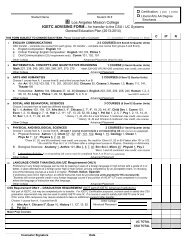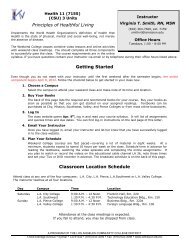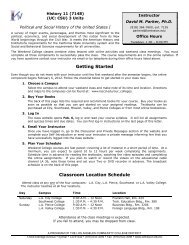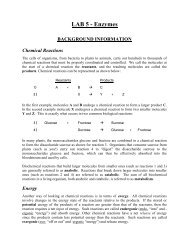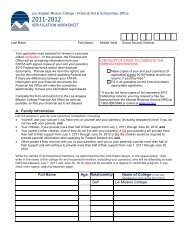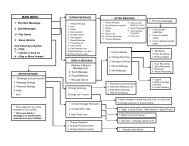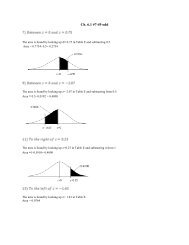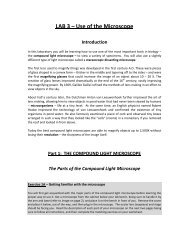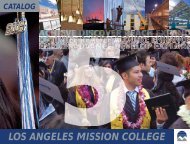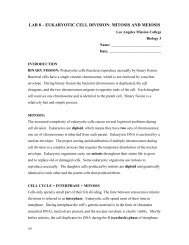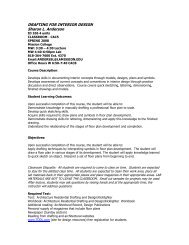Cultural Anthropology: Our Diverse World - Los Angeles Mission ...
Cultural Anthropology: Our Diverse World - Los Angeles Mission ...
Cultural Anthropology: Our Diverse World - Los Angeles Mission ...
Create successful ePaper yourself
Turn your PDF publications into a flip-book with our unique Google optimized e-Paper software.
Video Information<br />
<strong>Cultural</strong> <strong>Anthropology</strong>: <strong>Our</strong> <strong>Diverse</strong> <strong>World</strong><br />
<strong>Anthropology</strong> 102<br />
All DVDs are closed captioned.<br />
Lesson 1 - The Essence of <strong>Anthropology</strong><br />
<strong>Anthropology</strong> is the study of human beings, but to phrase the definition in these simple terms is to diminish the grand scope of<br />
this discipline overall. <strong>Anthropology</strong> delves deeply into every aspect of humankind, from its beginnings millions of years ago to<br />
the present day. Its subject matter ranges from the exotic to the ordinary, from faraway tribes to the structure of the human<br />
foot. This lesson explains the four fields of anthropology; defines the concept of holism; and describes how anthropologists<br />
approach their subject matter from a holistic and comparative cross‐cultural perspective in order to reach the broadest, most<br />
inclusive conclusions possible on their subject of interest. Each major field – cultural, physical (biological) and linguistic<br />
anthropology, and archaeology – is described, and situational material is included to illustrate how each field functions and<br />
interconnects with the others. Subfields to the four major fields, such as forensics and paleoanthropology, are introduced and<br />
discussed, and the concept that humans are biocultural beings because of the simultaneous adaptations of our biology with<br />
culture is illustrated. The video also introduces the student to the way anthropologists carry out their analyses through<br />
rigorous fieldwork and participant observation in order to create the ethnographies that describe humans cross‐culturally.<br />
Applied anthropology, sometimes referred to as the fifth subfield of anthropology, is introduced.<br />
Lesson 2 - Characteristics of Culture<br />
The state of Oaxaca, Mexico, is the backdrop of this lesson, which explores the nature of culture and how cultures are studied.<br />
The Oaxacan society is used to illustrate the basic characteristics of culture: an integrated, dynamic system of beliefs, values,<br />
and behaviors that are shared by the members of a society wholly; learned and based on symbolic systems; and constituting<br />
humankind’s most important method of adaptation. Jayne Howell’s work in Oaxaca aims to determine how this society in<br />
transition is adapting to the pressures imposed by outside forces. It illustrates some of the methods of research that<br />
ethnographers employ in a biocultural approach to discovering how the world’s diverse cultures function.<br />
Lesson 3 - Becoming Human<br />
Humans are first a biological species, Homo sapiens, but they are unique among all species in their capacity for cultural<br />
adaptations. This lesson first compares humans to modern primates, especially the great apes, in terms of biology, genetics,<br />
and behaviors. Next, it surveys the evolution of the line of pre‐human ancestors from the first bipedal species that emerged<br />
about 6 million years ago up to anatomically modern humans and their increasingly sophisticated cultural innovations. Finally,<br />
the concept of race is discussed as a social construct that has no biological validity.<br />
Lesson 4 - Communication & Culture<br />
This program focuses on the efforts of the Serrano tribe of Native Americans to revitalize their dying cultural traditions and<br />
language. The features and structures of human language in general are discussed, showing some examples from the Serrano<br />
language, and the role played by the descriptive linguist assisting them is examined. A discussion of sign languages reveals that<br />
they are in every way like all other human languages except that they are based on gestures instead of sounds. Nonverbal<br />
human communication systems are explored, as are various aspects of the fields of ethnolinguistics and sociolinguistics.<br />
African‐American Vernacular English is discussed as an example of a social dialect that marks membership in a group. The film<br />
closes with a focus on the Serrano children, who it is hoped will carry on the tribal language and traditions.<br />
Lesson 5 - Social Identity, Personality & Gender<br />
One of our universal questions is, “Who am I?” The answer is complex and begins with enculturation. Enculturation influences<br />
how you think, feel, and behave, and it starts at birth. It begins with being given a name. Naming ceremonies vary from culture<br />
to culture, but what you are called is an important device for self‐definition, and it also allows individuals to take their place<br />
within their group’s culture. As children develop physically, they also develop emotionally and psychologically. One aspect of<br />
this maturation is the development of self‐awareness. This is important for the individual and also for the entire community.<br />
Not only does everyone have a name, but individuals have their own personalities. It is now recognized that one’s personality<br />
is the product of both enculturation and one’s own genetic make‐up. When studying how personality develops, we cannot<br />
ignore the role that sex and gender may play, nor can we overlook the biological factors that may influence and differentiate<br />
male and female behaviors. Determining whether gender roles influence personality and social identity or vice versa may be<br />
difficult, but we know that gender roles vary greatly from culture to culture. It is also recognized that every culture has<br />
individuals who are transgenders—people who do not fall neatly within the proscribed male and female categories. Western<br />
cultures prefer to think exclusively in male and female gender roles, but many other cultures have created a “third gender” or<br />
even a “fourth gender” in which to place these individuals. As individuals, we not only need to know who we are but also how<br />
we fit in and belong to the culture into which we were born. Sometimes it gets complicated.
Lesson 6 - Subsistence Systems<br />
Regardless of language, geographic location or culture, the question is the same: “What are we going to eat today?” The<br />
response depends upon the subsistence system used by those asking the question. This lesson focuses on three types of<br />
subsistence patterns: foraging, horticultural/agricultural, and pastoralism. The Ju/’hoansi live in the Kalahari Desert in<br />
southern Africa. They are a prime example of the hunter/gatherer–foraging subsistence system. Their understanding of the<br />
ecosystem in which they live and their ability to adapt have led to their survival both as foragers and now as a more sedentary<br />
group. While foragers have little control over the availability of natural resources, they can ensure their survival by living<br />
within the carrying capacity of the environment. In contrast, people in food‐producing societies control the production of<br />
either plants or animals. Food‐producing societies tend to be sedentary. They live in larger groups than foragers and have<br />
more complex social and political structures. The most common form of horticulture is slash‐and‐burn cultivation, which<br />
relies on human power and has limited productivity yield. A third subsistence system is pastoralism, the managing of herds of<br />
animals. Many pastoralist societies live at such high altitudes that little agricultural activity can occur. The Yolmo of Nepal,<br />
featured in this lesson, have crossbred cows with male yaks to produce zomo, a hybrid cattle species that is biologically<br />
adapted to live at high altitudes. Since life is so precarious, the Yolmo must exploit the seasonal environments and supplement<br />
their diet and economy by practicing horticulture at the lower altitudes. Many pastoral groups practice transhumance, the<br />
seasonal migration of herds and people in order to maximize grazing opportunities. Common to all subsistence systems is the<br />
need for water. Who controls the water is at the heart of human survival. In the postindustrial era, traditional subsistence<br />
activities have been relegated to hobbies, such as hunting, fishing, and berry‐picking.<br />
Lesson 7 - Economic Systems<br />
Economic systems are the means by which a society produces, distributes and consumes resources and are intimately<br />
integrated with the other elements of the culture. In this lesson, the economic systems of several societies are examined as<br />
examples of how reciprocity, redistribution, and market exchange play a central role in the distribution of goods. The<br />
Ju/’hoansi of southern Africa exemplify foraging cultures in which food is not produced but rather collected as needed and<br />
distributed immediately according to the process known as generalized reciprocity. The Yolmo of Nepal traditionally practiced<br />
pastoralism and subsistence farming, using an exchange system of balanced reciprocity combined with redistribution. A<br />
Ghanian market run by women illustrates a traditional form of market exchange, and a Japanese fish market exemplifies the<br />
wholesale commercial market with international participants but with face‐to‐face transactions, according to Japanese cultural<br />
practices.<br />
Lesson 8 - Sex & Marriage<br />
The lesson opens with a wedding in Long Bow Village, in China, and shows the diverse nature of weddings from one culture to<br />
another, emphasizing that weddings are rites of passage, full of ritual and symbols that convey and emphasize the values of<br />
that society. The lesson defines marriage and suggests that this is one way that societies regulate sexual relations between<br />
men and women. It points out that all cultures include rules on who can marry whom because of the general concern<br />
regarding marriage between close family members, or incest. The incest taboo is discussed, and the narrator and expert<br />
anthropologists explain how it provides a structuring mechanism for marriage rules, endogamy and exogamy. Also discussed<br />
are arranged marriages, how they benefit specific societies, and the attitudes toward then as opposed to the Western ideals of<br />
romantic love.<br />
Lesson 9 - Marriage & Family<br />
The lesson begins with Helen Mendoza and Pam Privett explaining that families today take many forms. They are partners in a<br />
same‐sex marriage, raising children of their own. Lesson 8 explained why some cultures find polygamy a preferred marriage<br />
arrangement, and Lesson 9 highlights the familial and household benefits of the polygynous system. However, the lesson<br />
points out that not all such marriages are cooperative. Under some circumstances, competition among wives can cause serious<br />
tensions. The terms consanguinal family, conjugal family, and fictive kin are defined, and varying family forms such as nuclear<br />
family, extended family, and blended family are illustrated. The Yolmo, pastoralists of east‐central Nepal, are featured to<br />
illustrate how monogamy within a nuclear family organization functions within this group. Residence patterns and marriage<br />
customs, such as bride price and bride service, are discussed, and the reasons for their practice are illustrated. The final<br />
segment of the lesson comments on newer adaptations of the family made possible because of advances in reproductive<br />
technology and changes in adoption laws within the United States.<br />
Lesson 10 - Kinship & Descent<br />
The lesson opens with pictures of Chinese immigrants of the 1850s to the 1900s, explaining how those people faced enormous<br />
challenges when they moved to the United States. They faced discrimination and a sense of isolation because they lacked the<br />
assistance that had been provided through strong kinship ties in China. The lesson explains that kinships, or the strong familial<br />
networks within which individuals function, are made up of groups of family members that provide the essentials for survival.<br />
The lesson explains descent groups and lineages and points out that not all lineages trace descent the same way. Several kinds<br />
of descent groups are illustrated, and Chinese patrilineal descent is featured. Particular attention is given to explaining this<br />
complex system, in which a lineage goes back only four to six generations; conflicts arise in households that have become very<br />
large over time, and brothers splinter off and begin lineages of their own. The concept of clan (tsu) is discussed at length.<br />
Different systems of kinship are illustrated, where each group has established varying methods of defining relatives. The<br />
lesson explains the Eskimo, Iroquois, and Hawaiian systems.
Lesson 11 - Grouping by Gender, Age, Common Interest & Class<br />
This program explores concepts related to non‐kin‐based social groupings by focusing on the culture of the Black Indians of<br />
New Orleans. They are a common interest group that celebrates their own art and culture, culminating in their annual<br />
celebration of Mardi Gras separately from the better‐known White Carnival. Divisions within the group based on age and<br />
gender are discussed, as are its origins and history as an oppressed minority social class excluded from the white Mardi Gras.<br />
Finally the lesson examines the effects of hurricane Katrina on the culture of the Mardi Gras Black Indians and on the recovery<br />
of the city in general.<br />
Lesson 12 - Politics, Power & Violence<br />
This lesson explores the anthropological concepts of political organization and social control as practiced cross‐culturally. It<br />
opens with anthropologists Victoria Bernal and Laura Nader discussing the concepts of political organization in terms of<br />
power, authority, functions and in its four main forms: bands, tribes, chiefdoms, and states. Nader and William Ury then<br />
explore the various methods of maintaining social order across cultures, including interior and externalized controls,<br />
sanctions and laws. Methods of dispute resolution are described by Nader and Ury, and they debate the merits of alternative<br />
dispute resolution methods (ADR) in the United States. China’s control over citizens’ use of the Internet is used as an example<br />
of the interrelationships between social control, ideology, legitimacy, and the potential for the use of force by ruling powers.<br />
Nader and human rights activist Xiao Qiang then describe, in parallel fashion for comparison and contrast, their personal<br />
experiences with peaceful student protests at the University of California in Berkeley in the mid‐1960s and in Tiananmen<br />
Square in China in 1989, both of which brought violent reactions from their respective governments.<br />
Lesson 13 - Religion & Spirituality<br />
The program opens with a general discussion of the anthropological definition of religion contrasted with spirituality. This is<br />
followed by a close‐up view of some of the history, beliefs, and practices of Islam and Tibetan Buddhism through the eyes of<br />
several experts and practitioners. Discussions of anthropological concepts of religion across cultures are offered, with<br />
examples of the basic forms of religion, its specialists, and its rituals, as well as magic and witchcraft. The exploration of some<br />
of the social and psychological functions of religious practices and belief systems, especially focusing on Islam, conclude the<br />
lesson.<br />
Lesson 14 - The Arts<br />
This lesson focuses on visual, verbal and musical art forms. Since art is created in response to social, religious, political,<br />
economic, and aesthetic stimuli, anthropologists use it as a guide to understanding the values and ideals of culture. Being able<br />
to put art within a cultural context enables anthropologists to observe cultural dynamics. That is why tattoos, hip hop and hula<br />
provide insight into past and present cultures. You will also be reintroduced to the Pacific Northwest Potlatch ceremony. This<br />
once again will highlight the integrated nature of all aspects of culture.<br />
Lesson 15 - Processes of Change<br />
At the beginning of this lesson, anthropologist Leo Chavez comments that culture “is always transforming itself, always<br />
changing. It is always in the process of becoming something else.” Throughout history, cultures have changed because of<br />
environmental conditions, internal pressures, or external forces. Change comes quickly, or it may occur slowly. In any event,<br />
anthropologists chronicle cultural change and offer explanations as to why it happens. Anthropologist Eugene Cooper has<br />
tracked cultural change as reflected in the craft of Chinese furniture‐making during the 1970s and 1980s, emphasizing that<br />
societies change with the use of new technologies. The key term “diffusion“ is introduced and discussed within the context of<br />
the spread of the English language from the anthropologist to the group she/he studies. The lesson illuminates some of the<br />
benefits and problems that immigration poses for a culture. It focuses on the current migration of Mexicans and Central<br />
Americans to the United States. It illustrates why the Minutemen Civil Defense Corps was founded, and how their goals were<br />
formed in response to the perception that too many Mexican citizens were coming across the border into the United States<br />
illegally. In contrast, the human rights organization El Rescate was formed in 1981 in <strong>Los</strong> <strong>Angeles</strong> to assist individuals who<br />
had escaped the chaos in Central America and who sought refuge here. Both groups offer their own perspective on the impact<br />
of immigrants on American culture. The lesson also offers contextual information on post‐colonialism and explains the<br />
differences between rebellion and revolution.<br />
Lesson 16 - Global Challenges & <strong>Anthropology</strong><br />
Program Description<br />
This program explores the phenomenon of globalization, its complex forms, and its impact on the cultures of the world as well<br />
as the contributions that anthropology can make toward a better understanding of it. Wal‐Mart’s operations in China are<br />
shown as an example of how giant global corporations use structural power to expand business and profit in developing<br />
countries. The collaboration of the Bolivian government with another U.S.‐based global corporation, Bechtel, and the <strong>World</strong><br />
Bank illustrates how such partnerships can act against the best interests of the people. Finally, a Bangladeshi immigrant to the<br />
United States is interviewed, giving a personal perspective on the record‐high levels of external and internal migration<br />
occurring worldwide.
Lesson 17 - Applied <strong>Anthropology</strong><br />
The lesson begins with the anthropological definition of applied anthropology. This field of study refers to the application of<br />
method and theory to the analysis and solution of practical problems. It can be used, or “applied,” within the four<br />
subdisciplines of anthropology—physical (or biological), cultural, linguistic and archaeological. The lesson shows how a<br />
cultural anthropologist, Professor Mikel Hogan, practices applied anthropology within a hospital setting to help resolve some<br />
of the on‐the‐job problems that nurses face at this time of crises within the health‐care system in the United States. As the<br />
lesson progresses, viewers also see how linguistic anthropologist Breesha Maddrell works on the Isle of Man to help the<br />
culture there preserve and maintain the Celtic language of Manx Gaelic. Finally, the third segment of the lesson shows how<br />
physical anthropologists Amy Mundorff and Diane Cockle work in the area of forensics. Mundorff explains the educational<br />
qualifications required for a career in forensics, explaining that a strong background in biology or chemistry, plus a strong<br />
background in anthropology, particularly archaeology, is ideal. In general, this lesson gives very clear, varied examples of<br />
where applied anthropology is used in the workforce, how flexible the field is, and how it fits within the subfields of<br />
anthropology.



